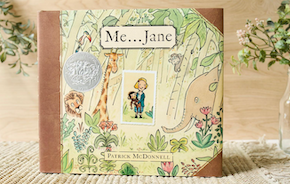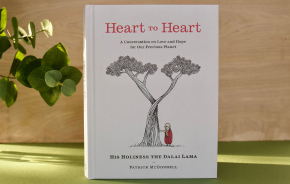The Rainbow Bridge:
Honoring Our Beloved Pets
Explore heartfelt Rainbow Bridge gifts and gentle guidance for navigating the loss of a pet.

What Is the Rainbow Bridge?
The Rainbow Bridge is comforting vision of a place beyond this life where animals go when they pass, free from pain and full of joy, waiting to be reunited with the humans who loved them. Some imagine the Rainbow Bridge vividly, as a place with rolling green meadows and happy paws, a place where old aches are forgotten. For others, it’s more symbolic — a way of reminding ourselves that love doesn’t end, even when a life does. The Rainbow Bridge crosses beliefs, traditions, and backgrounds, offering a source of comfort to anyone who has loved, and lost, an animal family member.
For all of us at MUTTS, the Rainbow Bridge is a symbol of the enduring bond we celebrate every day.
Navigating Loss and Healing:
In Conversation With an Animal Chaplain
Losing a pet is a unique kind of heartbreak. To help bring comfort, we sat down with Patricia Denys, a certified animal chaplain, for an open conversation about understanding pet loss, supporting others in grief, and gentle suggestions for navigating the personal journey of healing.
Scroll down to read excerpts from this touching Q&A, or read the full interview on our blog.
Rainbow Bridge Art Prints
Our Rainbow Bridge art prints are designed to bring a sense of peace and remembrance to your home. Available in a variety of sizes, these frameable prints are easy to display in a cozy nook, beside a favorite photo, or anywhere you’d like to keep your pet close. Some designs can even be personalized with the animal's name.
Rainbow Bridge Sympathy Cards
When someone loses a beloved pet, a few kind words can mean everything. Our pet sympathy cards are a gentle way to show you’re thinking of them — offering comfort, connection, and a reminder that they’re not alone. Each card is thoughtfully designed to help you express care during one of life’s most tender moments.
What to Write In a Pet Sympathy Card
It can be hard to find the right words when someone loses their closest companion, but acknowledging their feelings and letting them know they're not alone can mean the world. Here are some examples of what to write inside a pet sympathy card, to help you get started.
Begin From the Heart
The most meaningful pet sympathy messages come from a place of genuine understanding. Start by acknowledging their loss with gentle honesty: "I was so deeply moved to hear about dear Luna's passing" or "My heart aches with you as you say goodbye to sweet Charlie." These opening words let them know their grief is seen and shared.
Share Cherished Moments
If you were fortunate enough to know their companion, weave in a special memory that celebrates their unique spirit. Perhaps it's how Bailey's tail would thump against the floor whenever someone mentioned "walk," or how Oliver's purr could fill an entire room with comfort. These personal touches help keep precious memories alive and remind them of the joy their friend brought to many lives.
Extend a Loving Hand
Grief can feel isolating, especially when saying goodbye to a beloved animal friend. Let them know they don't walk this path alone: "Sophie brought such brightness to every visit - I'd love to sit with you and share our favorite stories about her when you're ready." Or "Just as Max was always there for your morning walks, I'm here for you any time you need a listening ear."
Finding Words for Different Journeys
Every grief journey is unique, and so is every message of support. Here are some gentle suggestions to help you express your care with sincerity and heart.
In Conversation With Patricia Denys, Animal Chaplain
Patricia Denys, MFA, is an artist, animal activist, creative director of Animal Culture magazine, educator, yogi, vegan, and an interfaith, interspecies animal chaplain ordained by the Compassion Consortium. She's also a great friend of MUTTS, and we're grateful to share her words of support and gentle guidance below.
"An animal chaplain helps animals live their fullest lives and helps them transition when it is time," says Patricia. "They offer help to animal parents, animal care workers, and animal people in general, navigate stress, grief, and compassion fatigue. Animal chaplains also encourage stronger human-animal (interspecies) bonds, individually and communally. Animal chaplains offer help with end-of-life care, decisions and rituals (interfaith), and bereavement support. An animal chaplain is also there for celebrations and victories for all animals and our planet."
Why do we often feel that losing a pet is just as painful, if not more so, than losing a human loved one?
Those of us who have experienced the pain of the loss of a companion animal, or any animal, know this pain all too well. Humans have intense bonds with an animal they love or one that is a part of their lives somehow. By that I mean you may feel a strong connection to the animals used for food or in containment, or wildlife in peril. Animals’ lives are shorter than humans. The shock of that short life being over can be very hard to process. Companion animals also demonstrate stability and routine. A big void is created when these things come to an end. Animals are sentient. They are aware. We see that time and time again. We want to be with them and protect them; they are our family.
What are some healthy ways to process and express grief after losing a pet?
Definitely seek support from friends, family, your veterinarian, and/or an animal chaplain. Animal grief is in our mainstream now. There is no shame in asking for help, ever. One needs to talk about the loss. It’s real. Consider taking a workshop on animal loss, creating a shrine, memorial, art-making, or a photo book. Volunteering is a great, healthy way to heal!
Do you have any advice for someone who feels stuck in their grief or like they should have 'moved on' by now?
“Moving on” is a very individual thing. There is no time limit on processing through one’s grief. Accepting the loss and adjusting one’s life accordingly takes time. You need to take your time. If you feel that you are experiencing symptoms of prolonged grief, a therapist can be of help.
How can rituals or memorials help with healing? Do you have any suggestions for meaningful ways to honor a pet’s memory?
Oh, there are so many wonderful things you can do! Humans have always embraced rituals. It is a way to connect to something. A ritual may be something within your religious practices, your own spirituality that you find comforting, or the daily ritual of taking a walk with your dog. That is a ritual for both of you!
A memorial can be a powerful tool for healing. It is a coping tool. It is a way to process. Creating an altar on a table for the one you have lost that includes photographs, something that was meaningful for that animal such as a toy, or adding flowers can be a positive expression of your feelings of loss. Re-wilding a small garden that encourages other animals to visit also creates a positive ecological benefit, or creating a small shrine you can carry with you are other ideas. Keeping a journal of your thoughts or sketches can have a profound effect on healing and on your life.
The simple act of writing to your loved one; what they meant to you, how much they are missed, what you enjoyed most about them, for example, is often a comfort. As an artist and a teacher of art, I know creating art can be cathartic and healing. I conduct art workshops on loss and celebration of animals and the planet. It is for non-artists especially. It has been an incredible experience to see what people can create as a way to work out their feelings and usually, how anxious they are to share with each other. It is a bonding experience about the power of love.
How can friends and family support someone who is grieving the loss of a pet?
I would say the main thing is for someone not to be dismissive of an animal’s life — any animal! Be patient and simply listen. One does not have to solve “the problem.” Most just want to be heard by an understanding ear and to be validated. If you want to help someone, the main thing is to acknowledge their pain and be supportive and accepting. Be a good listener.
Patricia Denys offers art workshops and journaling workshops on animal loss and the celebration of animals and nature. Learn more at her website, PatriciaDenys.com.
For more about navigating the loss of a pet, read the full conversation with Patricia on our blog.
"We never lose our loved ones. They accompany us; they don’t disappear from our lives. We are merely in different rooms.”
Paulo Coelho




















